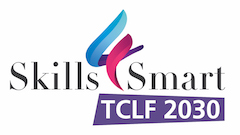The sooner young people are able to design their own professional project, the easier it will be for them to choose and succeed, first at school and then professionally.
It is difficult for youngsters to understand what they are best at, what skills they have and what career paths will enable them to express their talents and fulfil their expectations and dreams. With an advantage for the economic and social system: less risk of dropping out and better performance in the workplace. Orientation is therefore a fundamental strategic lever, not only for young people but for the entire economic and social system.
Helping youngsters choose the most suitable study and career path for their ambitions and inclinations is one of the objectives of the Erasmus + project named “Skills 4 Smart TCLF 2030”. The project focuses on the textile-clothing-leather and footwear sector, a sector involving more than 224,000 companies in the EU27, which generates more than 200 billion in turnover and provides employment for more than 2 million workers. It is therefore a fundamental sector for the European economy, with excellent employment prospects estimated for the coming years due to the expected generational change.
A multidimensional sector
The sector is influenced by fashion, which youngsters see as a world linked exclusively to creativity, communication and glamour. Behind the textile-clothing-leather and footwear sectors, however, there is content, tradition, heritage, technique, manual skills, scientific knowledge, in short, a very complex, complete and varied world where all those interested in the ‘fashion product’ can find a job that meets the most varied expectations. Moreover, the dynamism of the sector makes it particularly dynamic, stimulating, rich in innovation, able to satisfy people’s need for self-realization and recognition of their work, which becomes a “major art” (Arte maggiore). The textile-clothing-leather and footwear professions therefore have a very strong emotional content that makes them unique and attractive to young people. What is more, new technologies make it possible to review certain jobs in a more modern way, where craftsmanship and industrial and digital aspects create a unique combination.
If the uniqueness and beauty of the sector are well known to the older generations, the same is not obvious to the younger ones, who need guidance to discover the opportunities offered by the sector and the distinctive values which make it highly attractive.
For the next generation
This was the intention behind the first orientation activity for youngsters in the “Skills 4 Smart TCLF 2030” project, held in the textile district of Prato (Tuscany) – Italy – on 17 February, as part of the “E di moda il mio futuro” programme organised by Confindustria Toscana Nord thanks to the support of PIN. In the heart of Tuscany, where in a radius of 50 km there are the districts of textile, tanning, leather products and clothing, where Italy has the highest number of workers in the sector, where in the Middle Ages the “Arte della Lana” (what could now be considered as a trade association for textile companies specialized in wool) was considered an “Arte Maggiore” (Major Art), on a par with the professions of Notaries and Judges: right here a webinar was held on the professions of TCLF and its opportunities, to take up the tradition and renew it. The event involved about 300 students from the last year of high school in TCLF in Tuscany and elsewhere, to guide them to what the European project identified as the most innovative skills of the future, which will complement the “classic” skills of the key professional figures in the sector. But the message is broader: whatever your talents – scientific, manual, creative, digital, managerial or technical – within TCLF you can find a space where you can express them.
Revival of the sector
This is the message clearly expressed by the young workers involved during the webinar in their workplace. Through the interviews they highlighted how, having entered the world of work, they discovered a world much more attractive than they had imagined, rich in stimuli, varied and dynamic, where you never stop learning, rediscovering the emotions that are still imprinted on the older generations.
So let’s help youngsters understand this world in order to continue the successful European tradition, promote economic growth and beauty. Through digital channels, videos, new-generation multimedia content (this is the language of young people), we need to transfer the excitement of the sector, as well as convey important information and references for in-depth studies to help them understand who they can be professionally.
Author: Alessandro De Rosa / PIN

